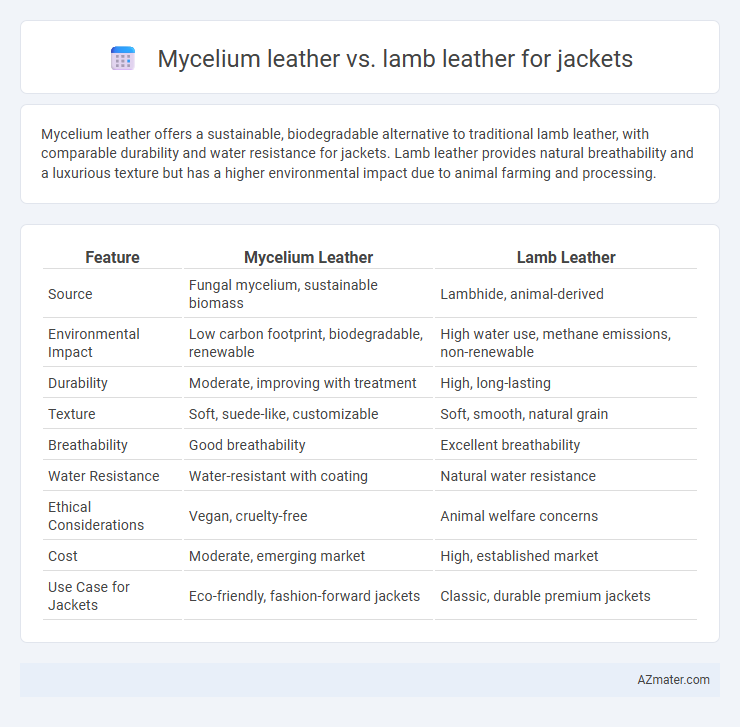Mycelium leather offers a sustainable, biodegradable alternative to traditional lamb leather, with comparable durability and water resistance for jackets. Lamb leather provides natural breathability and a luxurious texture but has a higher environmental impact due to animal farming and processing.
Table of Comparison
| Feature | Mycelium Leather | Lamb Leather |
|---|---|---|
| Source | Fungal mycelium, sustainable biomass | Lambhide, animal-derived |
| Environmental Impact | Low carbon footprint, biodegradable, renewable | High water use, methane emissions, non-renewable |
| Durability | Moderate, improving with treatment | High, long-lasting |
| Texture | Soft, suede-like, customizable | Soft, smooth, natural grain |
| Breathability | Good breathability | Excellent breathability |
| Water Resistance | Water-resistant with coating | Natural water resistance |
| Ethical Considerations | Vegan, cruelty-free | Animal welfare concerns |
| Cost | Moderate, emerging market | High, established market |
| Use Case for Jackets | Eco-friendly, fashion-forward jackets | Classic, durable premium jackets |
Introduction to Mycelium and Lamb Leather
Mycelium leather, derived from the root structure of mushrooms, offers a sustainable and cruelty-free alternative to traditional animal hides, demonstrating remarkable durability and flexibility ideal for jackets. Lamb leather, sourced from young sheep, is prized for its softness, breathability, and luxurious texture, making it a classic choice in premium leather jackets. Both materials serve distinct market demands, with mycelium leather leading in eco-friendly innovation and lamb leather excelling in traditional comfort and elegance.
Origins and Production Processes
Mycelium leather, derived from fungal root structures, is cultivated through a sustainable, biofabrication process that uses mycelium grown on agricultural waste, significantly reducing environmental impact compared to traditional leather production. Lamb leather originates from the skin of young sheep, undergoing complex tanning and chemical treatments to achieve softness and durability, yet it contributes to high water usage and greenhouse gas emissions. The contrast in origins and production highlights mycelium leather as an innovative, eco-friendly alternative to conventional lamb leather in jacket manufacturing.
Environmental Impact Comparison
Mycelium leather, produced from fungal root structures, offers significant environmental benefits over lamb leather by reducing water usage by up to 90% and cutting carbon emissions by approximately 80%. Lamb leather involves intensive livestock farming, contributing to deforestation, methane emissions, and high water consumption, whereas mycelium leather utilizes a biodegradable, renewable substrate with minimal ecological footprint. This sustainable alternative significantly lowers environmental impact while providing comparable durability and aesthetic qualities for jacket production.
Durability and Strength Differences
Mycelium leather, derived from fungal mycelium, offers impressive durability with high tensile strength and resistance to abrasion, outperforming many traditional animal leathers. Lamb leather, known for its softness and supple texture, generally lacks the same level of durability and strength, making it more prone to wear and tear over time. For jacket applications requiring long-lasting resilience, mycelium leather provides a sustainable and robust alternative to lamb leather.
Comfort and Breathability
Mycelium leather offers superior breathability due to its natural cellular structure, promoting airflow and moisture-wicking in jackets compared to traditional lamb leather. Lamb leather, known for its softness and flexibility, provides exceptional comfort but tends to retain heat and moisture, making it less breathable in warm conditions. Choosing mycelium leather enhances comfort in diverse climates by combining eco-friendly durability with excellent ventilation properties.
Aesthetic and Texture Variations
Mycelium leather offers a unique, natural grain pattern that mimics traditional animal leather while providing a more sustainable and eco-friendly option with a slightly matte and fibrous texture. Lamb leather is prized for its soft, smooth surface and supple feel, delivering a luxurious sheen and refined aesthetic preferred in high-end jackets. The textural contrast between the organic, slightly rougher mycelium leather and the sleek, silky finish of lamb leather creates distinct visual and tactile experiences for fashion consumers.
Ethical and Animal Welfare Considerations
Mycelium leather offers a sustainable and cruelty-free alternative to traditional lamb leather by utilizing fungal roots grown without animal harm or intensive farming practices. Lamb leather production involves animal slaughter and contributes to environmental concerns such as deforestation, water usage, and greenhouse gas emissions. Choosing mycelium leather supports ethical fashion by reducing reliance on animal-derived materials while promoting biodegradable and low-impact manufacturing processes.
Price and Accessibility
Mycelium leather offers a more sustainable and often more affordable alternative to traditional lamb leather, making it increasingly accessible for eco-conscious consumers. Lamb leather, prized for its softness and durability, typically comes at a higher price point due to animal farming and processing costs. Availability of mycelium leather jackets remains limited but is rapidly growing as production techniques advance and demand for plant-based materials rises.
Care and Maintenance
Mycelium leather requires minimal maintenance, needing only occasional wiping with a damp cloth to preserve its texture and appearance, making it highly durable and resistant to water and stains compared to traditional lamb leather. Lamb leather jackets demand regular care, including conditioning with specialized leather creams to prevent drying and cracking, along with careful cleaning to avoid damage from moisture and dirt. The eco-friendly Mycelium leather offers a more sustainable and low-maintenance alternative to the higher upkeep and sensitivity characteristic of lamb leather.
Future Trends in Jacket Materials
Mycelium leather, derived from mushroom roots, offers a sustainable and biodegradable alternative to traditional lamb leather, aligning with growing environmental concerns in jacket manufacturing. Advances in mycelium leather technology emphasize durability, breathability, and aesthetic versatility, making it a promising material for future fashion trends. As consumers increasingly prioritize eco-friendly options, the demand for mycelium leather jackets is projected to rise, potentially surpassing lamb leather in market share over the next decade.

Infographic: Mycelium leather vs Lamb leather for Jacket
 azmater.com
azmater.com